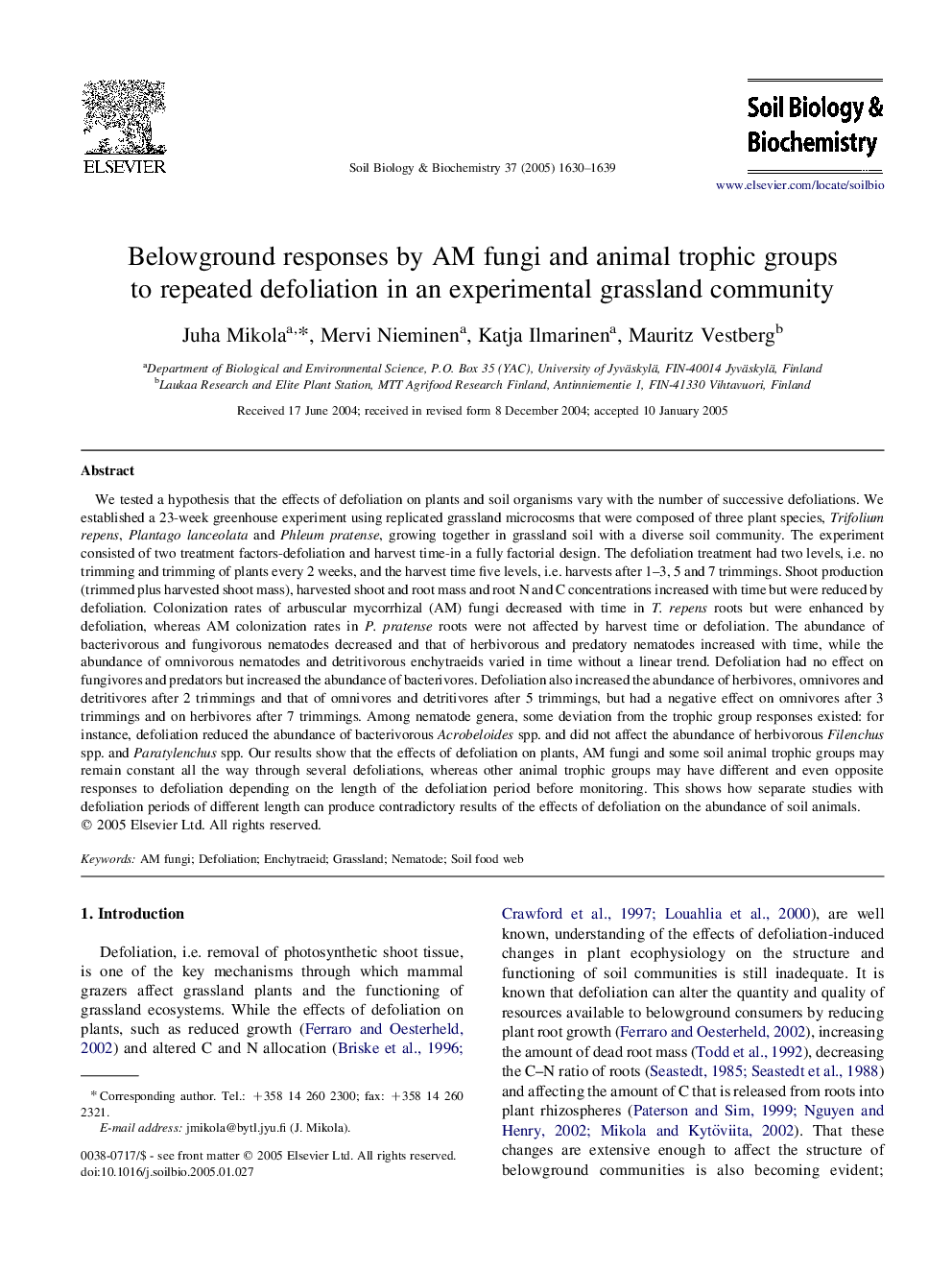| کد مقاله | کد نشریه | سال انتشار | مقاله انگلیسی | نسخه تمام متن |
|---|---|---|---|---|
| 10846170 | 1070040 | 2005 | 10 صفحه PDF | دانلود رایگان |
عنوان انگلیسی مقاله ISI
Belowground responses by AM fungi and animal trophic groups to repeated defoliation in an experimental grassland community
دانلود مقاله + سفارش ترجمه
دانلود مقاله ISI انگلیسی
رایگان برای ایرانیان
کلمات کلیدی
موضوعات مرتبط
علوم زیستی و بیوفناوری
علوم کشاورزی و بیولوژیک
دانش خاک شناسی
پیش نمایش صفحه اول مقاله

چکیده انگلیسی
We tested a hypothesis that the effects of defoliation on plants and soil organisms vary with the number of successive defoliations. We established a 23-week greenhouse experiment using replicated grassland microcosms that were composed of three plant species, Trifolium repens, Plantago lanceolata and Phleum pratense, growing together in grassland soil with a diverse soil community. The experiment consisted of two treatment factors-defoliation and harvest time-in a fully factorial design. The defoliation treatment had two levels, i.e. no trimming and trimming of plants every 2 weeks, and the harvest time five levels, i.e. harvests after 1-3, 5 and 7 trimmings. Shoot production (trimmed plus harvested shoot mass), harvested shoot and root mass and root N and C concentrations increased with time but were reduced by defoliation. Colonization rates of arbuscular mycorrhizal (AM) fungi decreased with time in T. repens roots but were enhanced by defoliation, whereas AM colonization rates in P. pratense roots were not affected by harvest time or defoliation. The abundance of bacterivorous and fungivorous nematodes decreased and that of herbivorous and predatory nematodes increased with time, while the abundance of omnivorous nematodes and detritivorous enchytraeids varied in time without a linear trend. Defoliation had no effect on fungivores and predators but increased the abundance of bacterivores. Defoliation also increased the abundance of herbivores, omnivores and detritivores after 2 trimmings and that of omnivores and detritivores after 5 trimmings, but had a negative effect on omnivores after 3 trimmings and on herbivores after 7 trimmings. Among nematode genera, some deviation from the trophic group responses existed: for instance, defoliation reduced the abundance of bacterivorous Acrobeloides spp. and did not affect the abundance of herbivorous Filenchus spp. and Paratylenchus spp. Our results show that the effects of defoliation on plants, AM fungi and some soil animal trophic groups may remain constant all the way through several defoliations, whereas other animal trophic groups may have different and even opposite responses to defoliation depending on the length of the defoliation period before monitoring. This shows how separate studies with defoliation periods of different length can produce contradictory results of the effects of defoliation on the abundance of soil animals.
ناشر
Database: Elsevier - ScienceDirect (ساینس دایرکت)
Journal: Soil Biology and Biochemistry - Volume 37, Issue 9, September 2005, Pages 1630-1639
Journal: Soil Biology and Biochemistry - Volume 37, Issue 9, September 2005, Pages 1630-1639
نویسندگان
Juha Mikola, Mervi Nieminen, Katja Ilmarinen, Mauritz Vestberg,